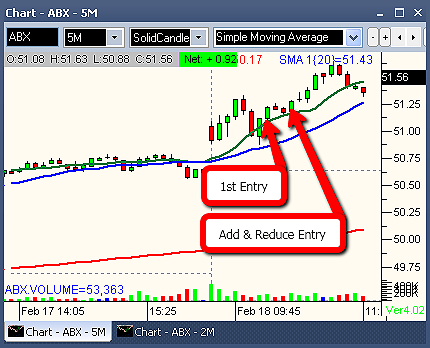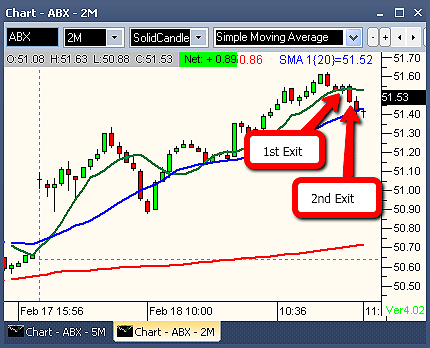
HOT TOPICS LIST
- MACD
- Fibonacci
- RSI
- Gann
- ADXR
- Stochastics
- Volume
- Triangles
- Futures
- Cycles
- Volatility
- ZIGZAG
- MESA
- Retracement
- Aroon
INDICATORS LIST
LIST OF TOPICS
PRINT THIS ARTICLE
by Jamie Theiss
The add & reduce method allows you to take maximum shares to profit while reducing your risk exposure.
Position: Buy
Jamie Theiss
Jamie Theiss is a full-time trader who daytrades stocks, swing trades forex, and from time to time position trades commodities.
PRINT THIS ARTICLE
DAY TRADING
Add And Reduce To Turbocharge Your Profits
02/23/11 09:02:50 AMby Jamie Theiss
The add & reduce method allows you to take maximum shares to profit while reducing your risk exposure.
Position: Buy
| The add & reduce method is intended to add share size while reducing risk exposure. This allows you to take maximum shares to target, thus turbocharging your profits, while keeping risk the same or smaller. I will show you February 18's trade in Barrick Gold (ABX) using three different scenarios to help explain the variations. I will use the same entry and exit prices to keep the comparison simple to follow. |

|
| FIGURE 1: ABX, FIVE-MINUTE |
| Graphic provided by: Blackwood Pro. |
| |
| Initial Trade The first entry is made at the pullback to the moving average. ABX has been bullish in the larger time frames with the moving averages on the 15- and 60-minute charts heading up. When this occurs, all pullbacks to the moving averages on smaller time frames (five-minute) are considered buyable events. We enter $0.01 over the green bar that bounced off the 20-period simple moving average (SMA)(blue) at $0.14 and placed our protective stop $0.01 under that bar at $0.88. That gives us a $0.27 risk. If we use a $100 risk per trade, that gives us 370 shares, which is rounded down to 300 shares. Our exit strategy for this trade is to get two bars of profits on the five- minute chart, then drop down to the two-minute chart and use half out on a bar-by-bar break and the remaining half out when the two-minute eight-period SMA (green) is broken. Out first exit is at 0.50 and the second exit quickly follows at 0.46. I take 200 shares off at 0.50, as I don't like to use odd-lots for better fills and less slippage. The remaining 100 shares comes off at 0.46. So with a profit of $0.36 on the 200 shares and $0.32 profit on the last 100, we get a profit of $104 for this basic trade. At a risk/reward of about 1:1, that's not too bad, as I have a 70-80 % ratio of winning trades using this method. Now let's see how to improve this trade. |

|
| FIGURE 2: ABX, TWO-MINUTE |
| Graphic provided by: Blackwood Pro. |
| |
| The Add & Reduce As you can see on the five-minute chart (see Figure 1), we have a pullback to the moving averages as soon as we enter the initial trade. Remember, we use all pullbacks to the moving averages as buying events. When we have a green bar, take out a red bar at the moving averages, and we enter again at $0.24. We buy an additional 300 shares at $0.24, which brings our average cost to $0.19 for the entire 600 shares. Our new stop is $0.01 below that red bar at $0.13, which leaves only a six-cent risk on the whole 600 shares, or $36 risk per trade. We have doubled our share size and reduced the risk by almost two-thirds. If we use the same exit strategy, we have 300 shares out at $0.50 and 300 shares out at $0.46. But remember we have a higher average cost per share of $0.19, so that leaves us with 300 shares at a profit of $0.31 and 300 shares with a $0.27 profit, or $174 profit on this trade. Using our new risk of $36 leaves us an adjusted risk/reward of 4.8:1 -- much better. |
| Aggressive Add, But No Reduce Aggressive traders can choose a third option. Using the second entry point of $0.24, aggressive traders might choose to keep the original risk per trade of $100 and add an additional 600 shares to their original 300, giving them 900 shares total with an average cost of $0.22 and using the new stop of $0.13, leaving 11 cents' risk. This maximizes the shares to profit and keeps the original $100 risk per trade in place. Using the same exit strategy and taking 500 shares off at $0.50 leaves $0.28 of profit, with our average cost being $0.22, and 400 shares out at $0.46 leaves a profit of $0.24. That gives us $140 and $96, which totals $236 profit, using this aggressive method and a 2.3:1 risk/reward. As you can see, choosing the aggressive trade brings more total profit but keeps the original risk amount. Traders should be comfortable in accepting this risk. See Figure 2. |
| Play around with this concept and you will begin to see opportunities to implement this method into your trading plan. Use this add & reduce method to turbocharge your profits by taking maximum shares to target and reducing your risk at the same time. |
Jamie Theiss is a full-time trader who daytrades stocks, swing trades forex, and from time to time position trades commodities.
| E-mail address: | jamie_theiss@yahoo.com |
Click here for more information about our publications!
PRINT THIS ARTICLE

|

Request Information From Our Sponsors
- StockCharts.com, Inc.
- Candle Patterns
- Candlestick Charting Explained
- Intermarket Technical Analysis
- John Murphy on Chart Analysis
- John Murphy's Chart Pattern Recognition
- John Murphy's Market Message
- MurphyExplainsMarketAnalysis-Intermarket Analysis
- MurphyExplainsMarketAnalysis-Visual Analysis
- StockCharts.com
- Technical Analysis of the Financial Markets
- The Visual Investor
- VectorVest, Inc.
- Executive Premier Workshop
- One-Day Options Course
- OptionsPro
- Retirement Income Workshop
- Sure-Fire Trading Systems (VectorVest, Inc.)
- Trading as a Business Workshop
- VectorVest 7 EOD
- VectorVest 7 RealTime/IntraDay
- VectorVest AutoTester
- VectorVest Educational Services
- VectorVest OnLine
- VectorVest Options Analyzer
- VectorVest ProGraphics v6.0
- VectorVest ProTrader 7
- VectorVest RealTime Derby Tool
- VectorVest Simulator
- VectorVest Variator
- VectorVest Watchdog
